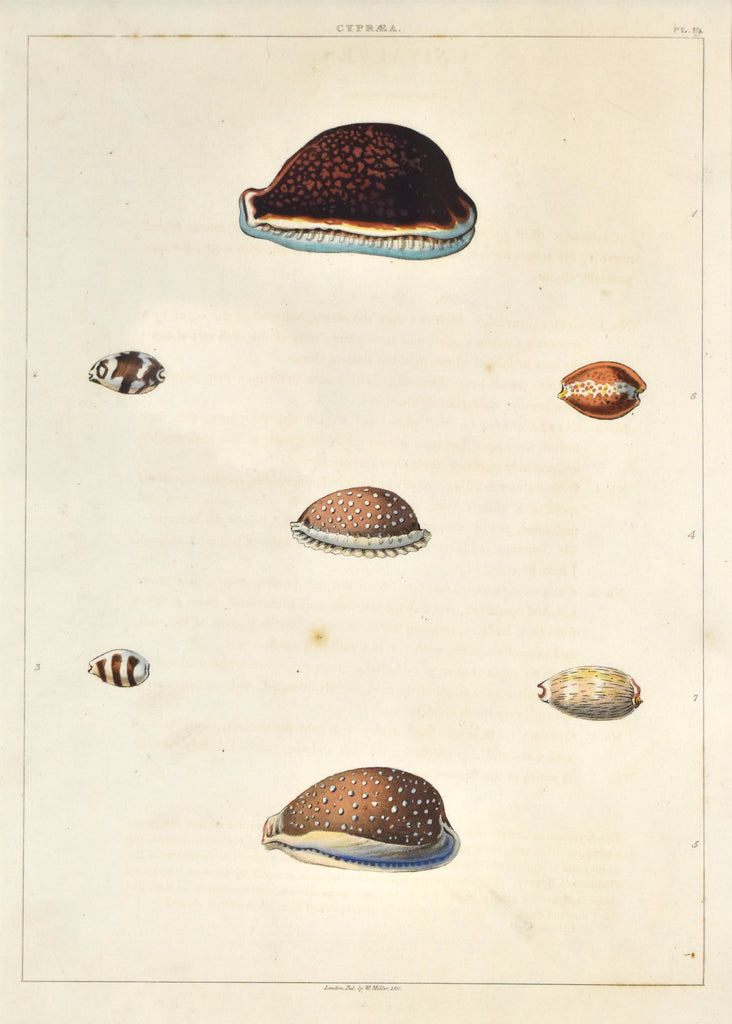-
Title: Cypraea, PL. 19
-
Author: George Perry
-
Date: 1811
-
Medium: Hand-colored aquatint
-
Condition: Very Good +
-
Inches: 9 3/4 x 13 1/2 [Image]
-
Centimeters: 24.77 x 34.29 [Image]
-
Product ID: 3010034
George Perry, British naturalist and expert in malacology (the study of mollusks), published two major natural history works during his lifetime. One of them Arcana; or the museum of natural history, a richly-illustrated natural history magazine, was released in monthly installments from January 1810 to September 1811. He published his other major work, Conchology, or the natural history of shells, in 1811. The majority of Perry’s contemporaries ascribed to Linnaean taxonomy, the system of natural classification devised by Swedish botanist Carl Linnaeus in the eighteenth century. However, Perry adhered to the taxonomic system and theories of evolution popularized by French naturalist Jean-Baptiste Lamarck. As a result of these dissenting views, Perry’s work was deliberately ignored at the time by many of his fellow British naturalists. Very little is known about him today.
Includes the following page of corresponding descriptive text:
UNIVALVES. PLATE XIX.
Genus. CYPRAEA.
Character. Shell generously oval and orbiculated; cheek of the mouth folded inwards; the mouth narrow, and wholly covered on each side with teeth; the apex generally obscure.
Species.
No. 1. Cypraea Obtusa. Shell of a dark red colour, softened at the edges by a rich orange colour; mouth and teeth white; ends of the shell very obtuse; the apex invisible. A native of the Eastern Ocean.
No. 2. Cypraea Ursellus. Shell white, richly streaked with a map pattern of dark brown; ends pointed, bisected.
No. 3. Cypraea Asellus. Shell white, and striped like the above, with dark brown, the stripes, however, are not waved irregularly in this instance, but are precisely regular in their form and number.
No. 4. Cypraea Jenningsia. Shell of a beautiful pink colour, spotted with raised spots of a white colour; mouth of a pale pink colour, furbelowed and undulated, two dark spots of brown at each end. It is in the Museum of Mr. Jennings, in honour of whose zeal in Conchology (it being unique), I have here named it.
No. 5. Cypraea Camelopardalis. Shell of a pale purple, verging to a brown tint, and spotted all over like the last shell, with white raised spots; it differs from that, however, in being larger, in having no dark sports at the ends, and in the form of the teeth. It is a native of the Red Sea.
No. 6. Cypraea Chalcedonia. Shell of a strong red, spotted with marks of the same colour; the edges of the beak slightly crenated, and the segments of the ends very much divided.
No. 7. Cypraea Isabella. Shell ovate, of a pale flesh-colour, richly streaked with lines and dots of black; the ends and apex touch slightly with red. A native of the Eastern Seas.
REMARKS
The Cypraea (or Cowry) is so named from the circumstance of a beautiful shell of the genus having, as it is said, been presented to the temple of Venus at Cyprus; and, indeed, the beauty and splendour of these shells render them worthy of being offered at the shrine of the Goddess of Beauty. The distribution of forms in this class is easily ascertained; the round shape, and narrow mouth, forming the chief and most obvious characteristics, so that, like the Cone and the Strombus, they are easily distinguished from all the other classes.


